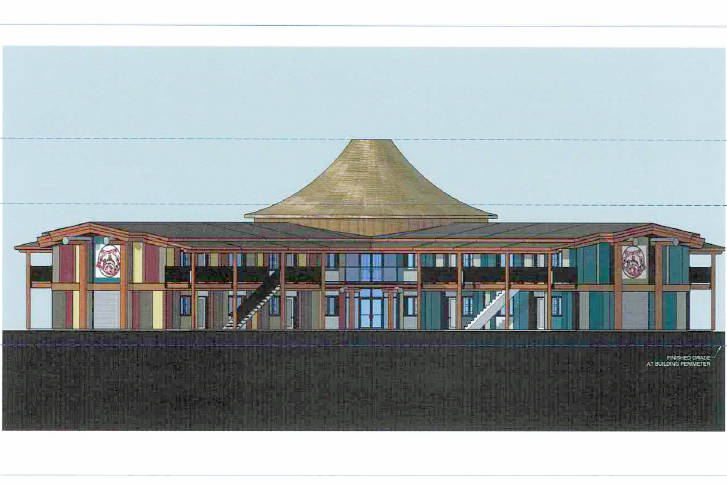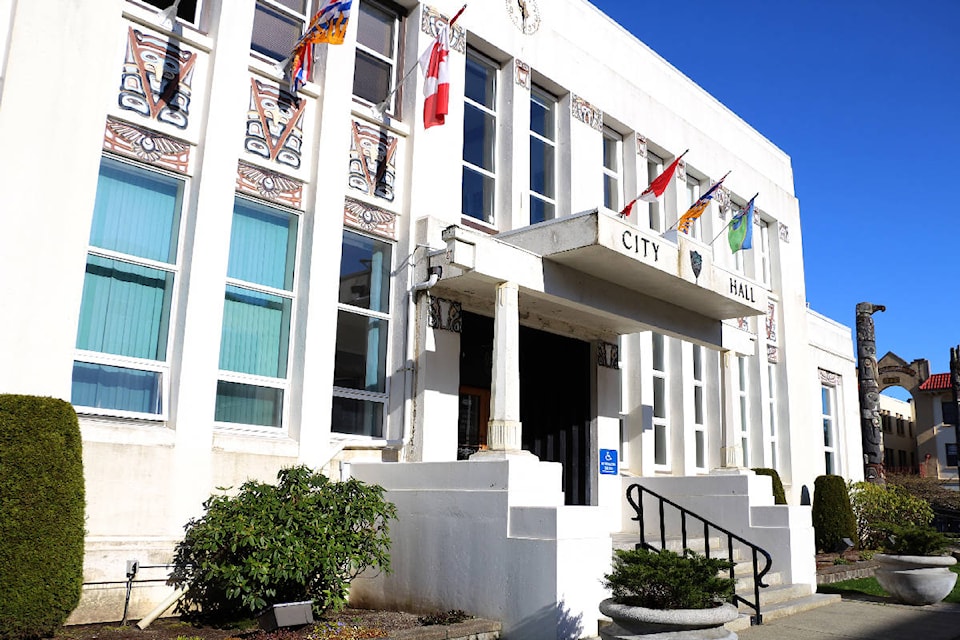Mayor on vacation
Mayor Lee Brain was absent from the meeting and Councillor Blair Mirau served as acting mayor.
Seniors housing proposal receives approval
A proposed 42-unit seniors housing complex received approval from city council to proceed with a building permit.
A public hearing was held on Monday, June 26 and no one was present to speak against the project and the proposed variances to existing bylaws and permits, allowing the project to move forward.
Bylaw amendments No. 3411 and 3412, changing official community plan map designation from ‘Open Space and Parks’ to ‘Residential’ and re-zoned from ‘Public Facilities Zone’ (P1) to ‘Multiple Family Residential Zone’ (RM2), both passed and a building permit variance, allowing two of the completed buildings to have metallic “hat” shaped roofs, was also passed. The non-liveable roof structures increase the height of two of the buildings by 4.9 metres (16 feet).
City planner, Zeno Krekic, said the Metlakatla Development Corporation (MDC) has stated the proposed complex will be open to seniors 65 and older. Previously, the discussed age range was 55 and older.
Councilllor Gurvinder Randhawa raised concerns about the change in age range and how existing seniors housing, such as BC Housing, consider people aged 55 as seniors.
“It was completely left up to the applicant,” said Krekic, explaining to the council that if the city wanted to determine ages of people in houses, they would require a covenant on the property, “They decided on 65 and I think that’s appropriate.”
City approves borrowing $100,000 to hire consultants on short-term cell block fix
In response to requests by the RCMP, the city will borrow $100,000 in short-term financing to hire consultants to determine the costs to build a short-term fix at the city RCMP detachment.
Due to changes to rules outlining cell block safety, the city cell block has been out of compliance since 2008.
In 2012, after public engagement sessions, the council of the day deferred upgrading the existing cell block as it was believed, at the time, to be better value to spend money on a new detachment, according to the report by Corrine Bomben, chief financial officer for the city.
Five years later, and no target start date for a new detachment, the RCMP are no longer willing to accept the risks posed to the prisoners, the police memo states.
The RCMP has brought in a team to identify the bare minimum upgrades, which could be made to improve prisoner safety and the $100,000 suggested will be used to determine the cost of architectural, mechanical, electrical and construction costs.
Other funding options were explored, including using the Prince Rupert Legacy Fund or accumulated surplus, but it was not considered reasonable as there is no long-term benefit to the city.
Other options presented, in lieu of completing temporary upgrades, included transporting prisoners to and from a facility in another community, building a temporary facility or increasing the number of guards, but all three would see a higher cost than making the proposed minimal modifications to the existing cell block.
“Before I stepped into that building, I was of the opinion of ‘it can’t be that bad’,” said councillor Wade Niesh, speaking to the proposal, “After touring the building and seeing what the problems are, the building definitely needs to be replaced.”
Niesh added that despite the city not being able to afford a new building, if a short-term fix is not implemented, the RCMP will build a new facility and send the city a bill.
“We have to do something.”
Councillor Joy Thorkleson raised concerns about the cost of the consultant fees and asked if past consultation reports could be used in the proposed upgrades to the current cell block. Bomben responded that previous consultation reports were related to a complete renovation to the existing cell block and not the bare minimum approach now acceptable to the RCMP.
Thorkleson responded that she thought the previous council had spent a lot of money on consultant fees and hoped some of the work could be used for this project.
“$100,000 and have nothing more than a couple of consultants to draw nice pictures that we already have,” Thorkleson said, adding she’d rather see the money go towards the building cost.
Councillor Barry Cunningham agreed with both Niesh that a new building was required and Thorkleson that $100,000 was a lot to spend on consulting.
“It’s something I think we have got to take a serious look at,” he said, “If we keep putting Band-Aids on it, pretty soon the Band-Aids will fall off too.”
The motion to approve borrowing funds to proceed with design consulting was passed with a friendly amendment capping the amount at $100,000.
Resolution from a closed meeting
On April 24, at council’s closed meeting, Cary Dalton, Brent Patriquin and Stephanie Lysyk were all appointed by motion to two-year terms to the Prince Rupert Library Board. The board is the corporate body responsible for the operation of the library.
Bylaw amendment adopted
The proposed Fireworks Regulation Amendment Bylaw No. 3415, 2017, which replaced a 1996 fireworks regulation, would see sky lanterns banned in Prince Rupert.
At the last meeting, Councillor Barry Cunningham was the lone vote against the proposed ban but after two weeks of research, he changed his mind on the final vote.
“There’s been quite a few fires caused by these [lanterns],” he said, adding that other damage, including environmental, changed his mind.
Future community and street names should have Tsimshian influence says councillor
Councillor Joy Thorkleson, speaking to the prospect of a future community naming committee better reflect the community at large.
“In recognition that Prince Rupert is situated in the traditional territory of the Tsimshian first nations and that a large majority of place and street names already established within the city do not reflect Tsimshian culture or heritage, that at least 75 per cent of the new names will be of Tsimshian culture or heritage and written in Sm’algyax [the regional language,] she said. “As well as in English.”
She added that it may be more appropriate for the community to suggest appropriate names and have them sent to local bands to ensure name choices weren’t divisive.
In addition to new streets and communities, Thorkleson suggested that if existing street names or places can be translated into Sm’algyax, it should be added to the sign.
“It’s a policy, [and] not just having a naming committee on what kind of, what I would consider, white-middle class or upper-class male names we can add to the streets of Prince Rupert,” she said. “In recognition that almost 50 per cent of our community is First Nations and we are on the unceeded traditional territory of the Tsimshian, I would suggest that we develop some kind of policy that reflects that.”
Acting Mayor Blair Mirau suggested that Thorkleson develop a notice of motion to submit to council so debate on the proposed policy could occur.
After the meeting, Thorkleson said further consultation was required with First Nations before the policy could be written.
“Whether the local First Nations have an elder’s committee or if there are only certain names that would be appropriate,” she said, “we need to have a protocol.”

